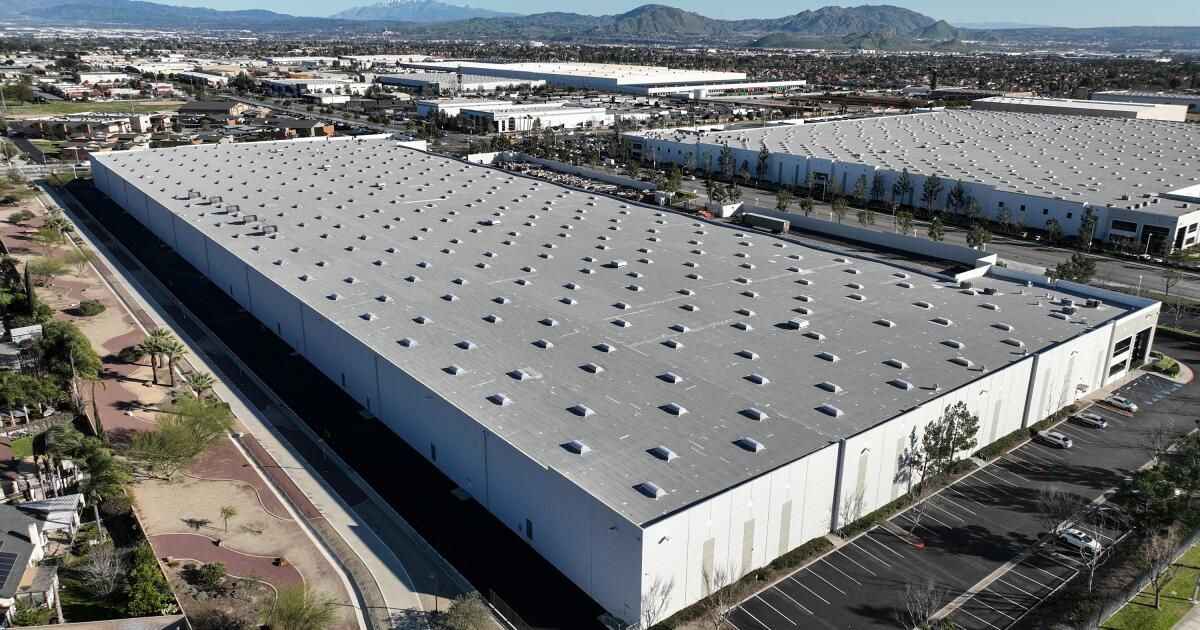Xochitl Pedraza moved to San Bernardino County eight years ago. After three decades of living in the city, unincorporated Bloomington offered her a rural community where she could buy an acre of land and raise chickens.
But the Pedraza neighborhood has become more industrial in recent years as developers have turned large swaths of property along the 10 Freeway into a logistics corridor for e-commerce, connecting goods shipped to Southern California ports with online shoppers around the country. While proponents of the developments say they bring jobs and infrastructure improvements, many residents who live in their shadow lament pollution, traffic and neighborhood disruption.
There was already an avocado distribution center across the street from Pedraza’s home; now there’s an Amazon fulfillment center on the corner bringing in “trucks after trucks after trucks,” Pedraza said. The incessant honking and beeping penetrates his soundproof windows.
She and her 8-year-old grandson suffer from dry eyes, nasal congestion and a chronic dry cough, symptoms she attributes to dust from the warehouse construction and ozone pollution in the region.
A bill on Gov. Gavin Newsom's desk would set location and design standards for industrial warehouses that supporters say would better protect the health of residents like Pedraza.
Assemblyman Juan Carrillo (D-Palmdale), a co-author of the legislation, has described the measure as a “very delicate compromise” that resulted from lengthy negotiations among a working group that included labor, health, environmental and business representatives.
But the bill has drawn strong opposition from a wide range of environmental, community and civic groups across the state who object to the secrecy in which the bill was crafted in the final days of the session and who say it fails to hold warehouse developers to higher standards.
Beginning in 2026, AB 98 would prohibit cities and counties from approving new or expanded distribution centers unless they meet specific standards. New warehouse developments would have to be located on arterial roads or local highways that are primarily intended for commercial uses. And storage sites would have to be within several hundred feet of so-called “sensitive sites,” such as housing, schools and health care facilities.
Additionally, if a developer demolishes a home to build a warehouse, the bill would require two new affordable housing units for every unit destroyed. The developer would have to provide displaced tenants with 12 months' rent.
Some regulations would need to be enacted in the state’s “warehouse concentration region” — Riverside and San Bernardino counties and a dozen Inland Empire cities — by 2026, two years earlier than the rest of the state.
While some labor groups support the bill, a number of environmental, business and community organizations oppose it. Several cities also opposed the legislation, which according to an analysis by the Senate Appropriations Committee, calls for sweeping updates to the plan that could result in one-time costs to cities and counties ranging from tens of millions to potentially hundreds of millions of dollars.
Environmental advocates are especially concerned about the bill's setback requirements for projects involving warehouses of 250,000 square feet or more that are within 900 feet of homes, schools, parks or health care facilities.
In those cases, the bill would require truck loading docks to be located at least 300 feet from the property line in areas zoned for industrial use; and 500 feet from the property line in areas not zoned for industrial use. Warehouses would also have to meet design and energy efficiency standards.
Pedraza, a Bloomington resident, said the set distances aren't enough. The rules also don't take into account that truck traffic and pollution problems are magnified in overburdened communities like Bloomington, he said.
“The whole community is surrounded by warehouses now,” he said. “No matter how far away they are… they still affect us.”
The bill would simply enshrine current warehouse development practices in law and undermine local efforts to advocate for the much larger setbacks recommended by state agencies, said Andrea Vidaurre, senior policy analyst for the People’s Collective for Environmental Justice in San Bernardino.
In a 2022 report on best practices for storage projects under state environmental laws, the state attorney general's office recommends locating storage facilities so that their property lines are at least 1,000 feet from the property lines of sensitive sites such as homes and schools. It cites the State Air Resources Boardwhich in 2005 estimated an 80% reduction in contaminant concentrations within approximately 1,000 feet of a distribution center.
“If this law passes, we’re basically saying, ‘It’s OK to keep doing business as usual; let’s keep building like this,’” Vidaurre said. “We’ll continue to see warehouses being built across the street from homes and schools, because it will be OK under the law.”
Assemblywoman Eloise Gomez Reyes (D-Colton), another co-sponsor, acknowledged during a Senate committee hearing last week that AB 98 preserves jobs and enacts warehouse standards, but “it's not the perfect bill.”
Earlier this year, he introduced a bill stating that warehouses could be located within 300 metres of schools, homes, health care facilities and other sensitive sites only if they included a minimum setback of 230 metres and adopted specific mitigation measures. The bill was in its first committee.
Gomez Reyes said the distancing requirements in AB 98 could serve as a limit.
“I do not believe that the sensitive receptor restrictions in this bill adequately protect our most vulnerable communities,” Gomez Reyes said during the hearing. “It is important to note, however, that they are only a minimum. And nothing in this bill prevents cities or advocates from pushing for stricter standards with local cities and counties.”
Karla Cervantes launched the Mead Valley Coalition for Clean Air earlier this year to fight the proliferation of warehouses in her unincorporated community of about 20,500 people in Riverside County. She said developers will not agree to larger reductions than those required by legislation.
Riverside County already recommends that warehouses be designed so that there is at least 300 feet between the property line of a sensitive site and the nearest dock gate. While it is “very rare” for developers to agree to a larger setback, he said, they sometimes offer larger landscaped areas to obscure the view of the facilities.
If AB 98 becomes law, he said, “it’s going to be even more difficult for us to try to push for improvement.”
Newsom has until Sept. 30 to sign or veto the bill.
This article is part of The Times article. Equity Information Initiative, funded by the James Irvine Foundationexploring the challenges faced by low-income workers and the efforts being made to address them. California's economic divide.












